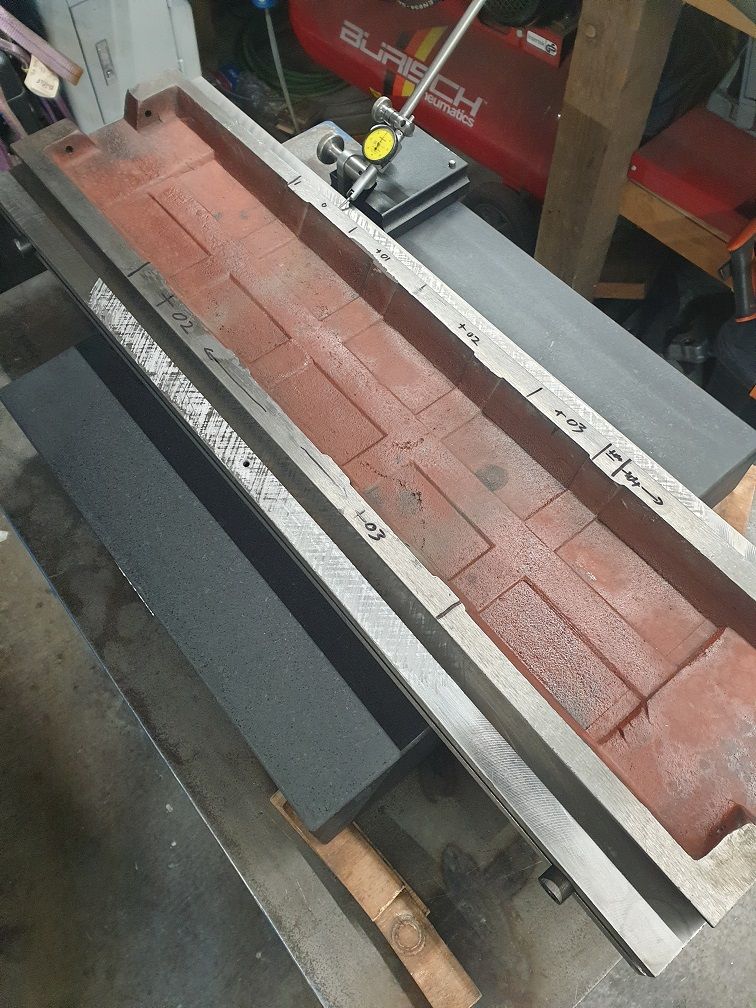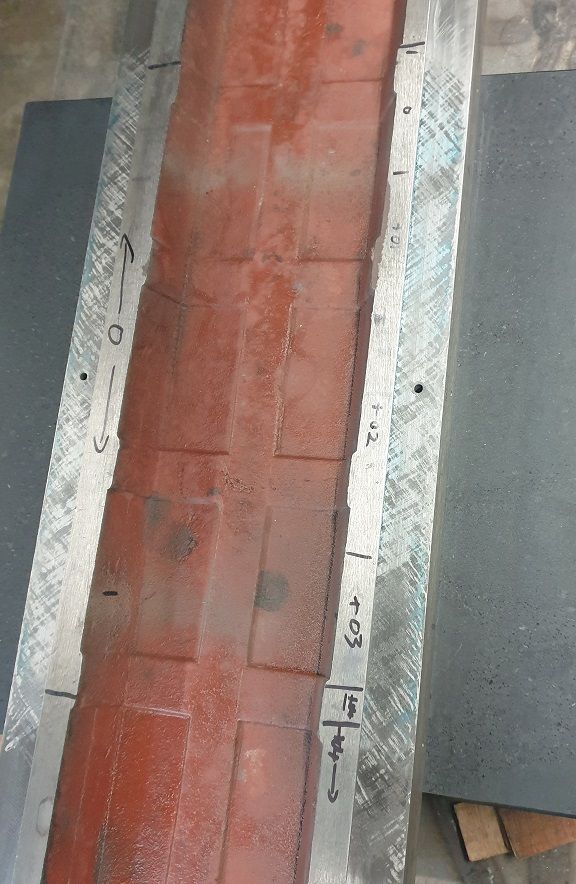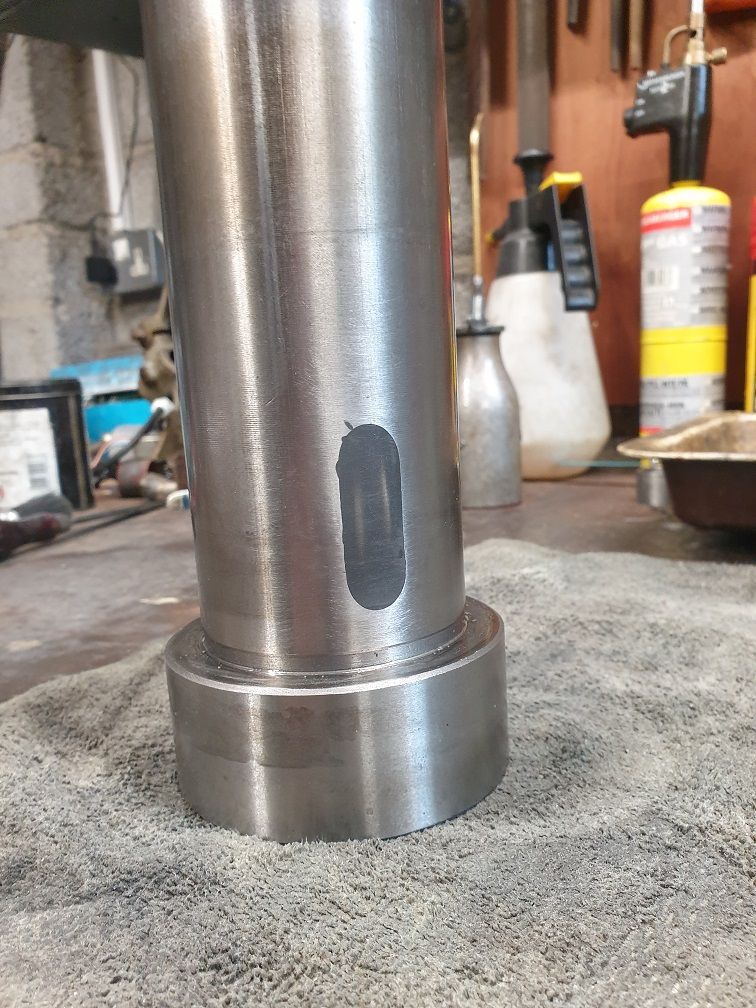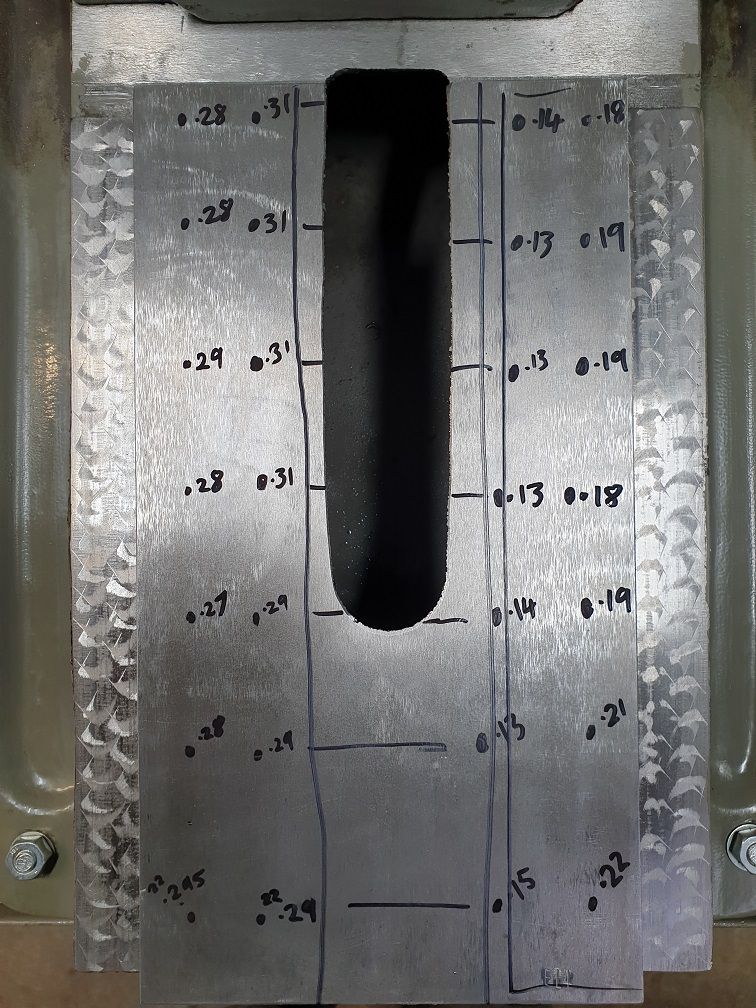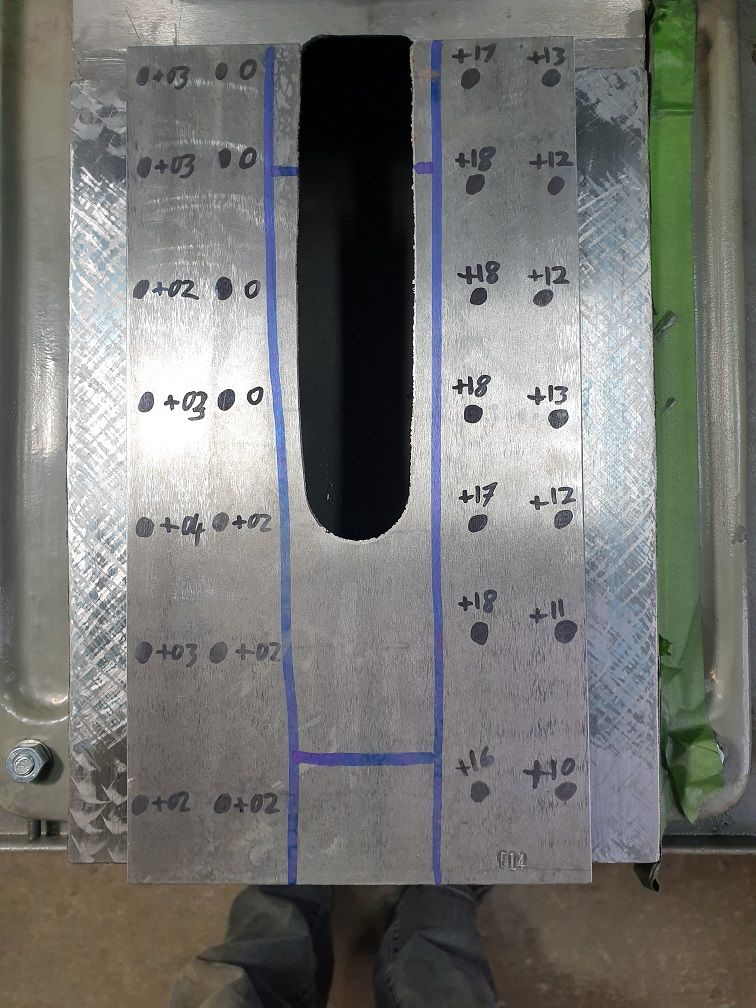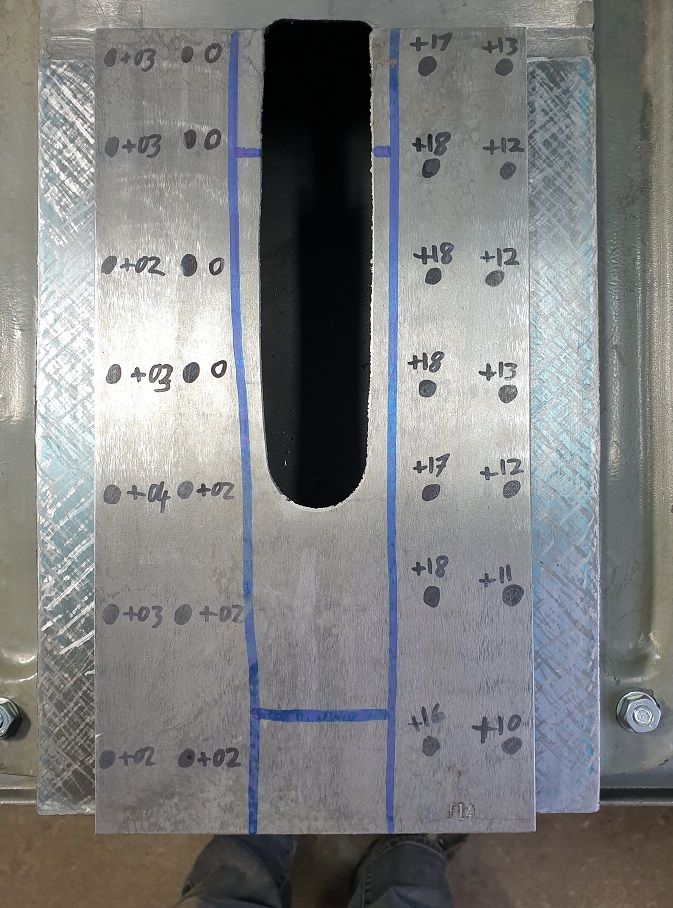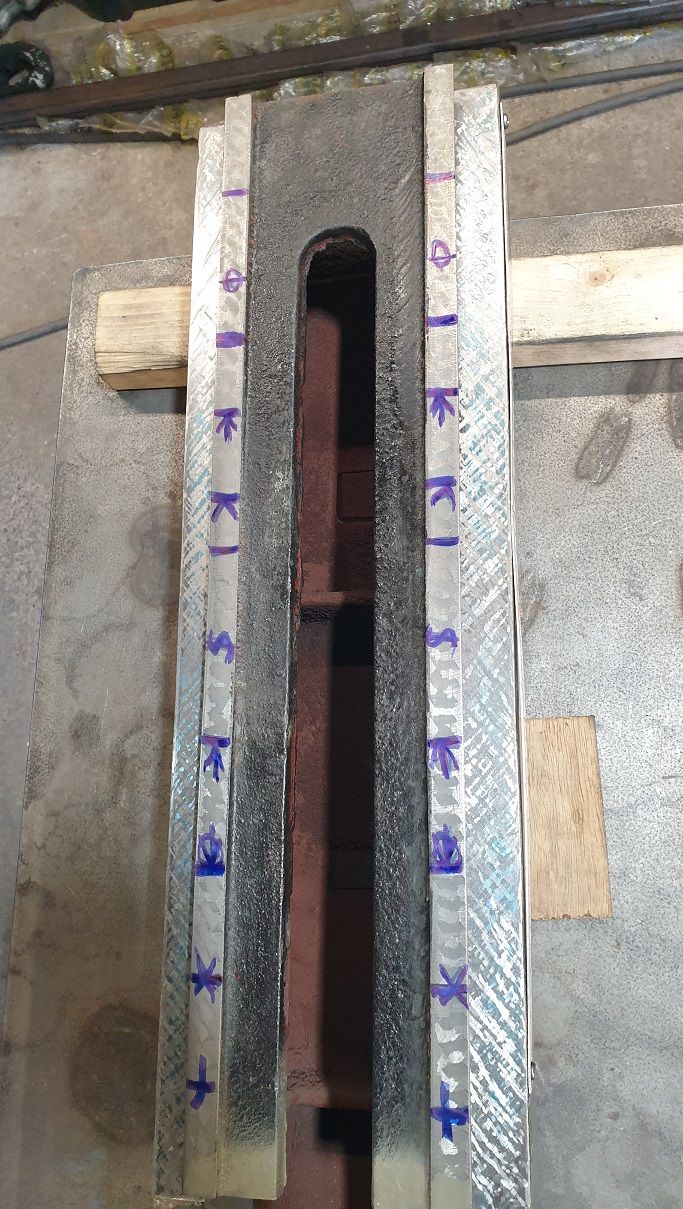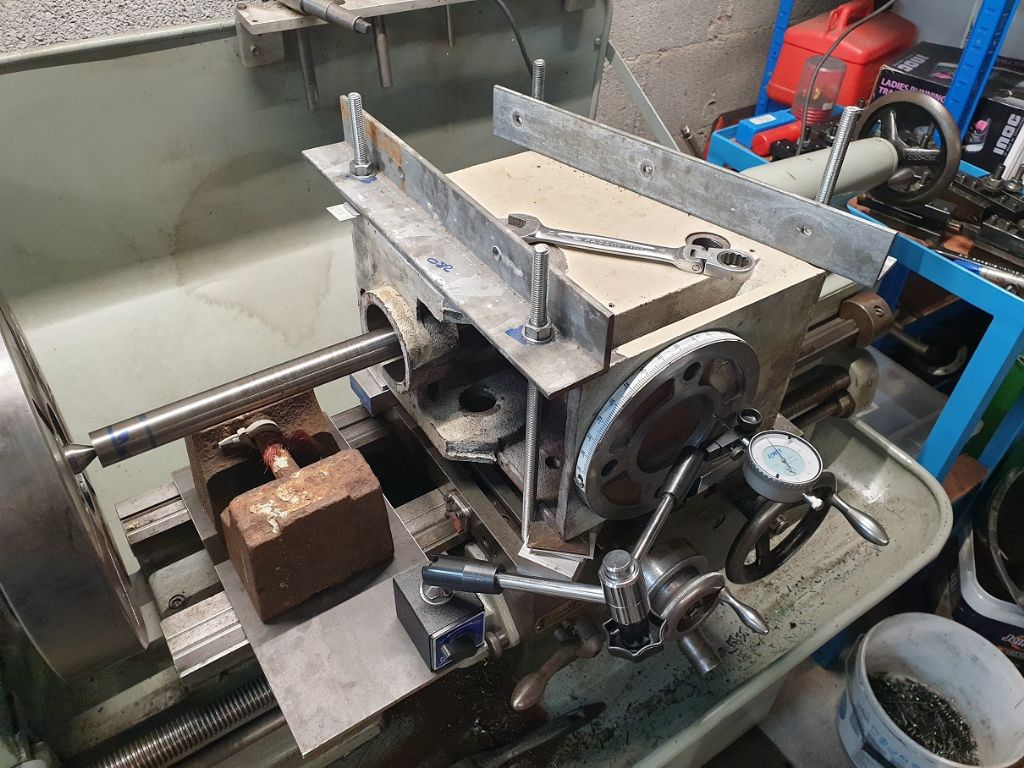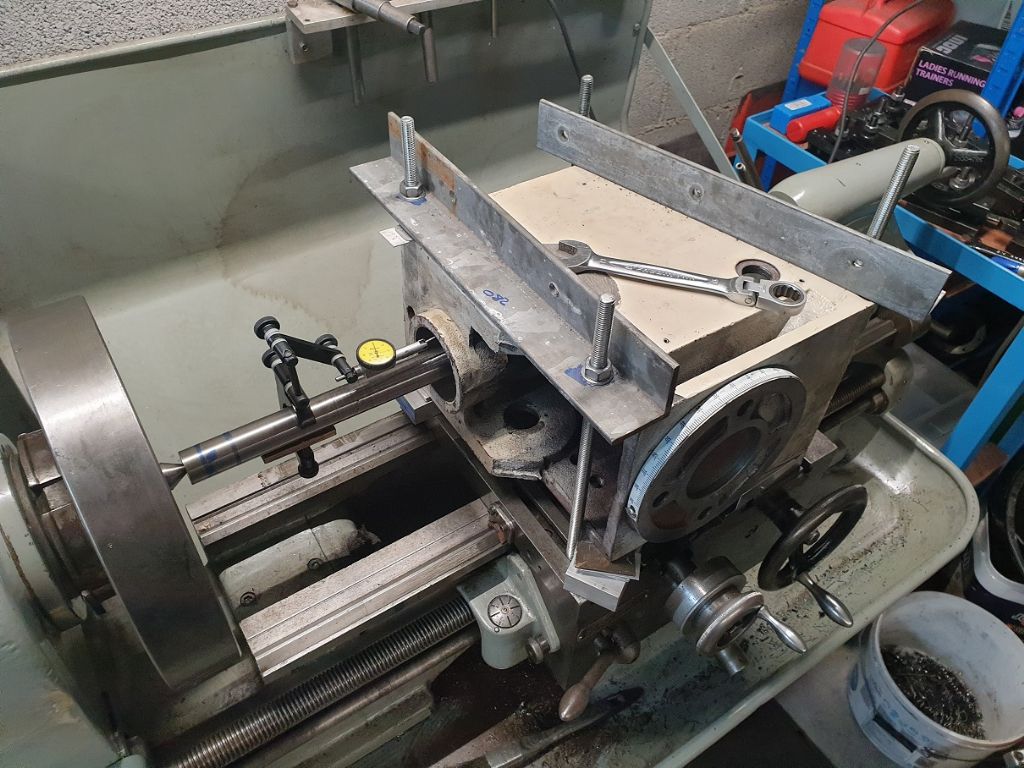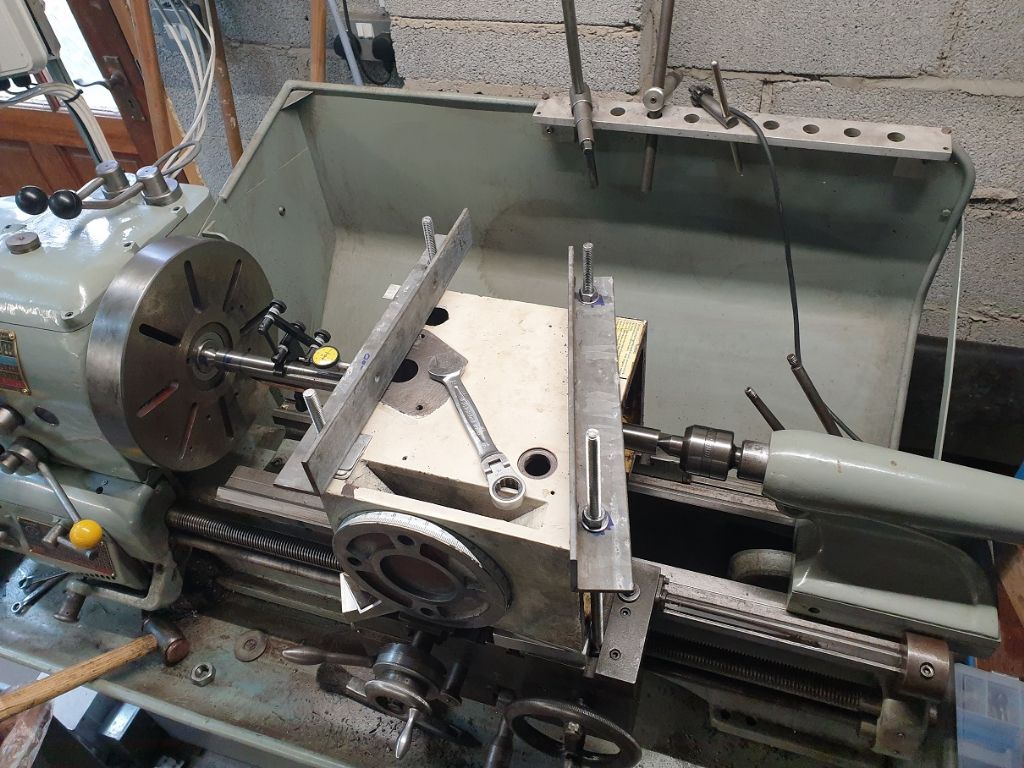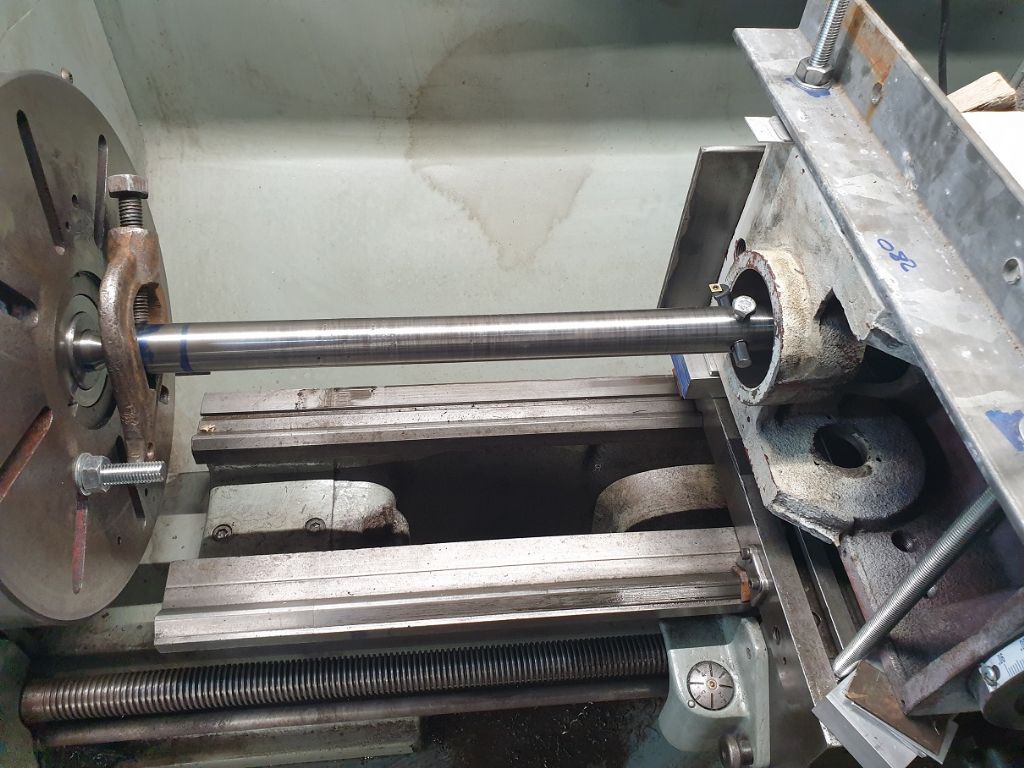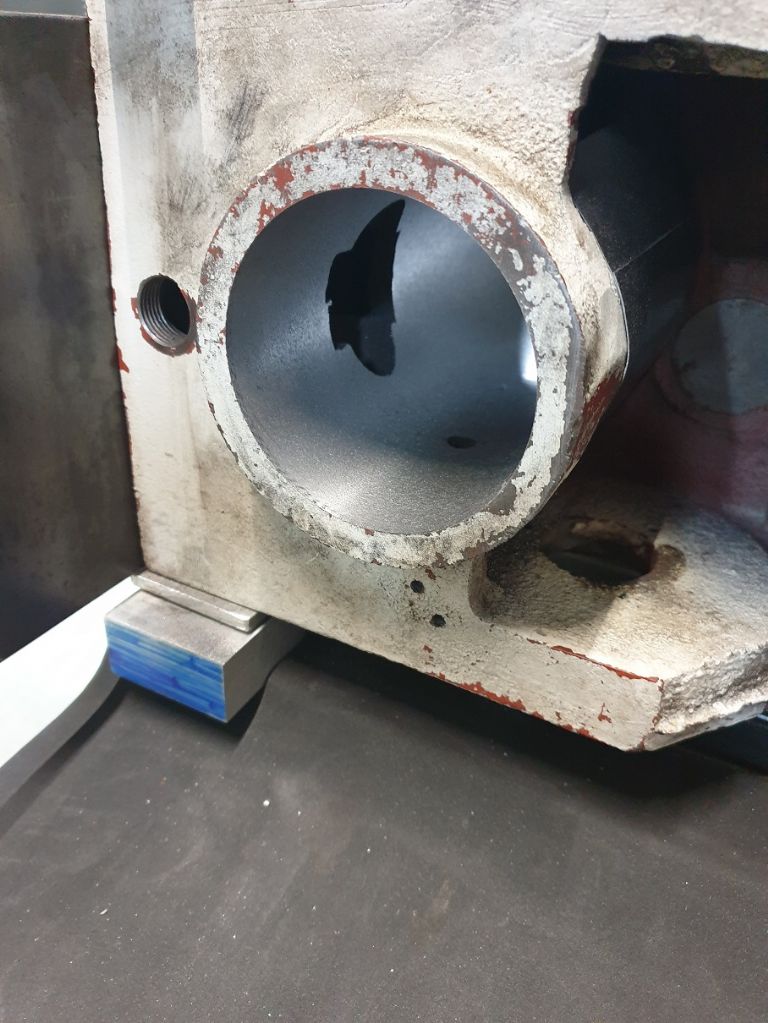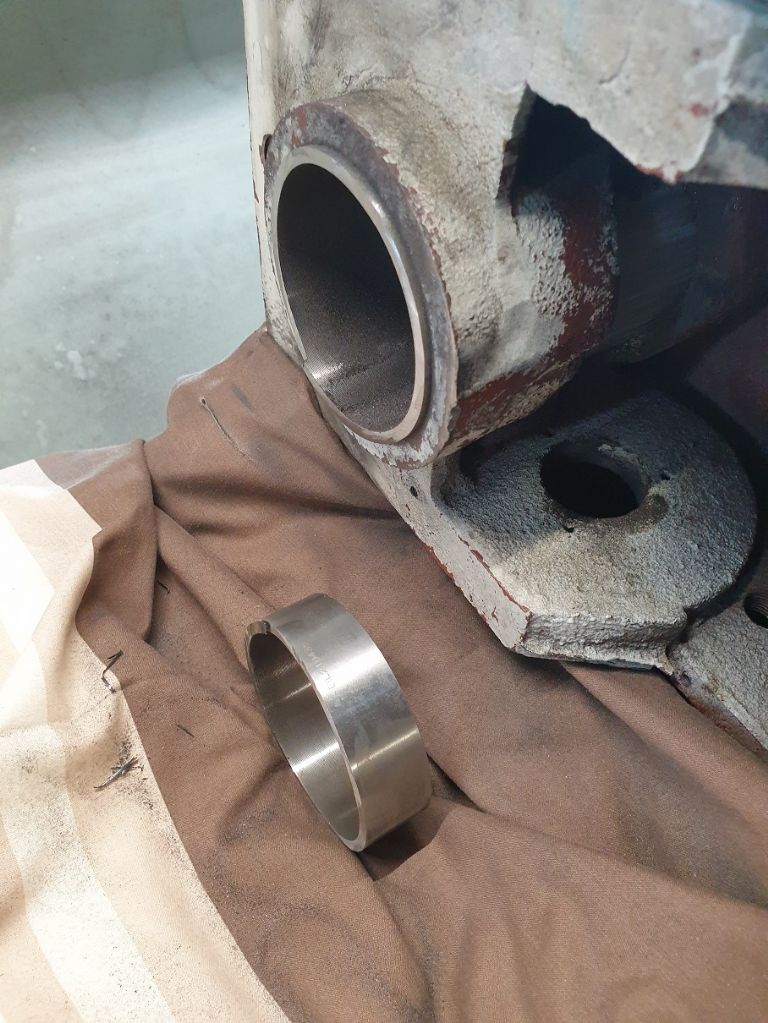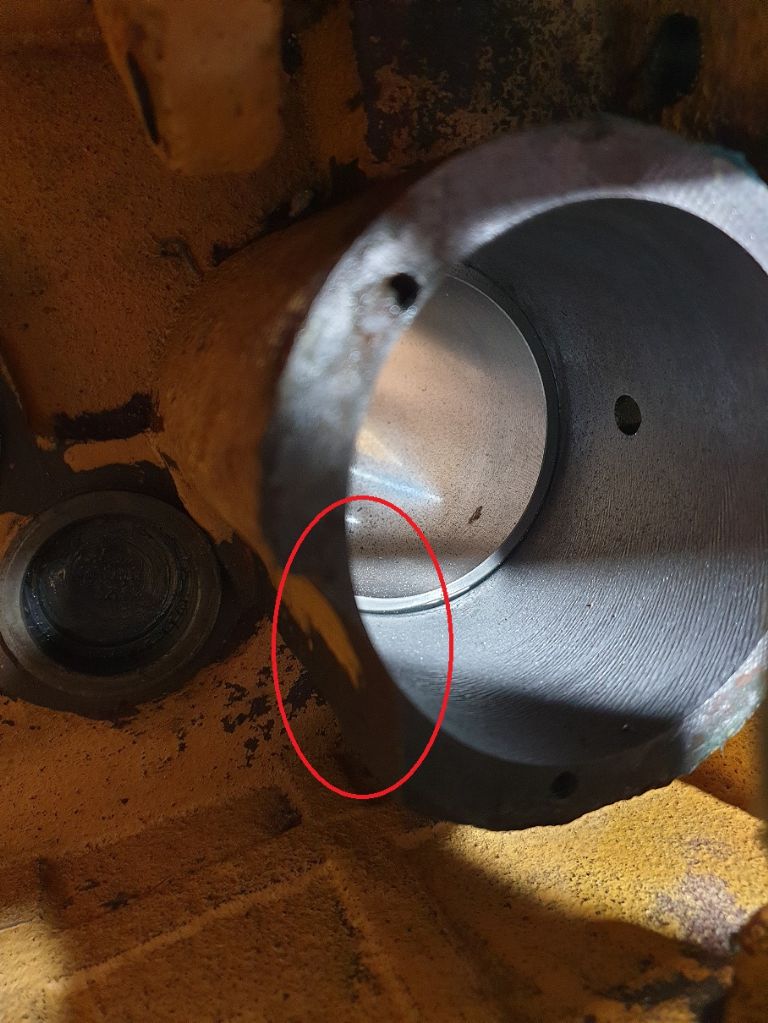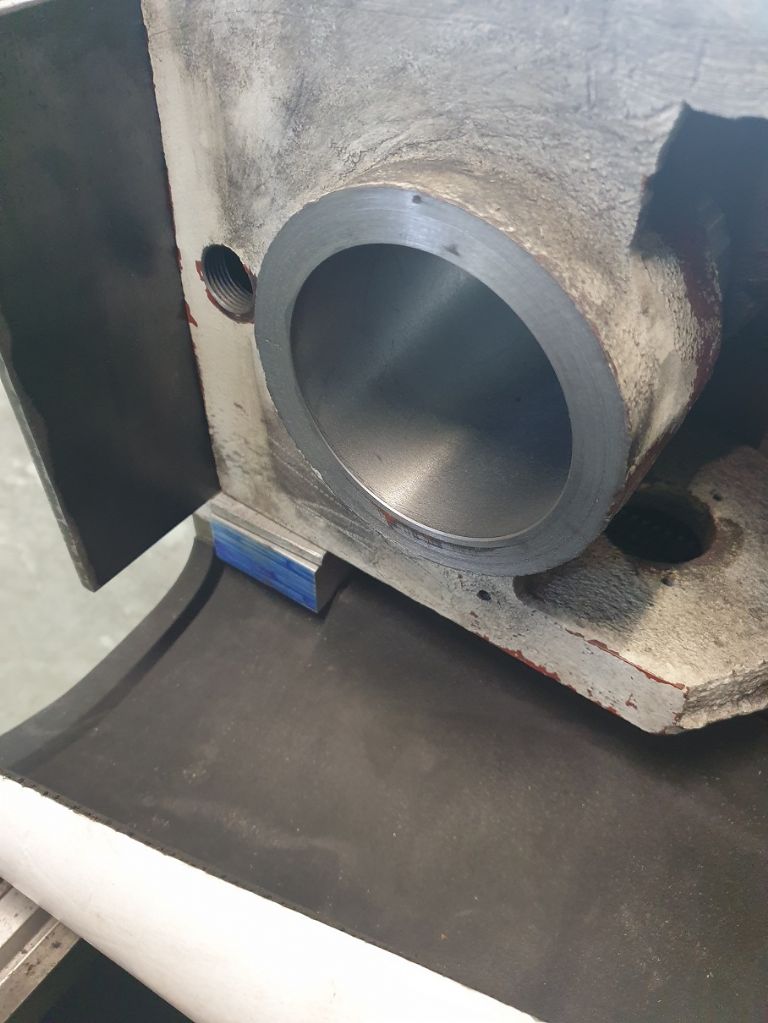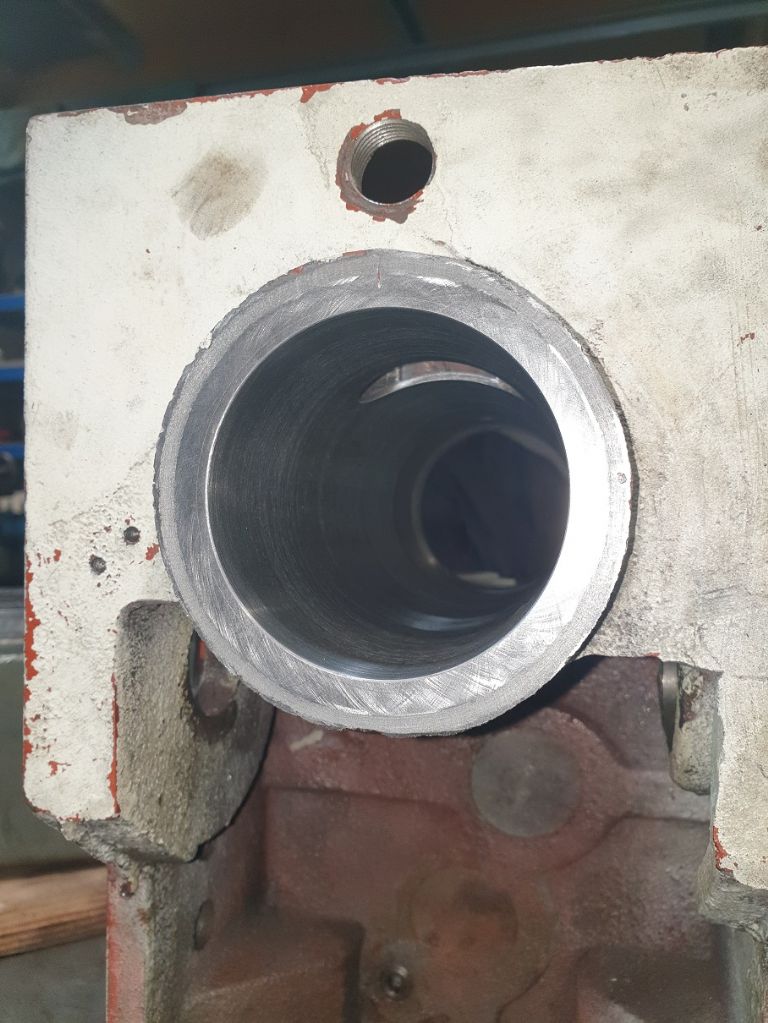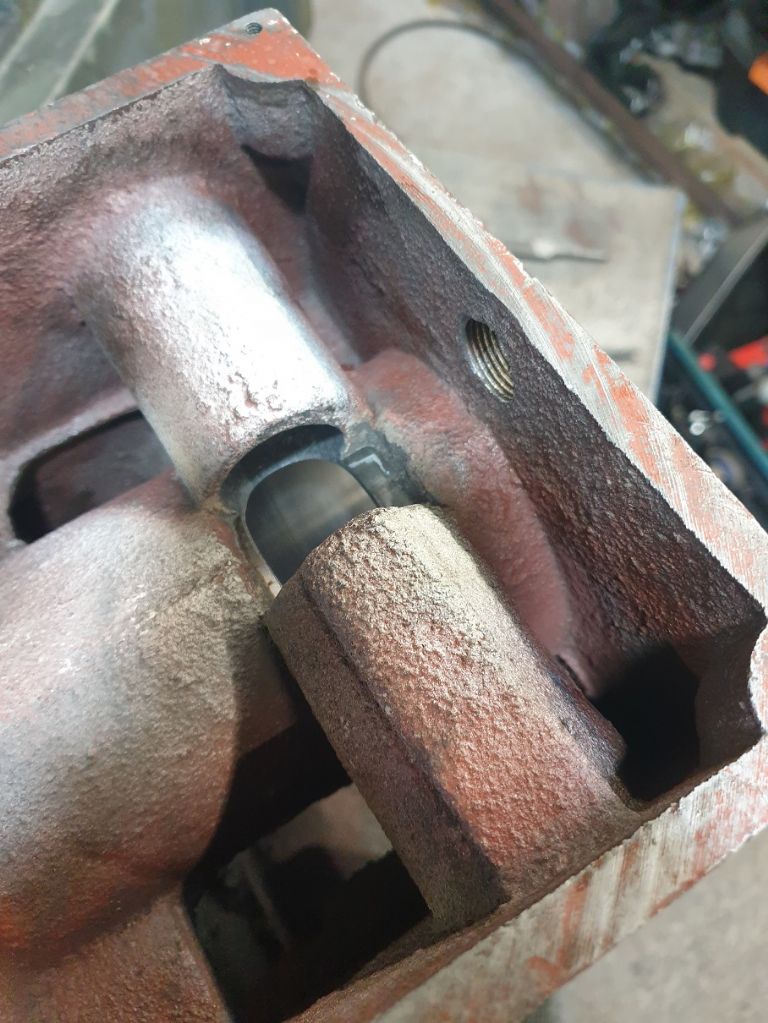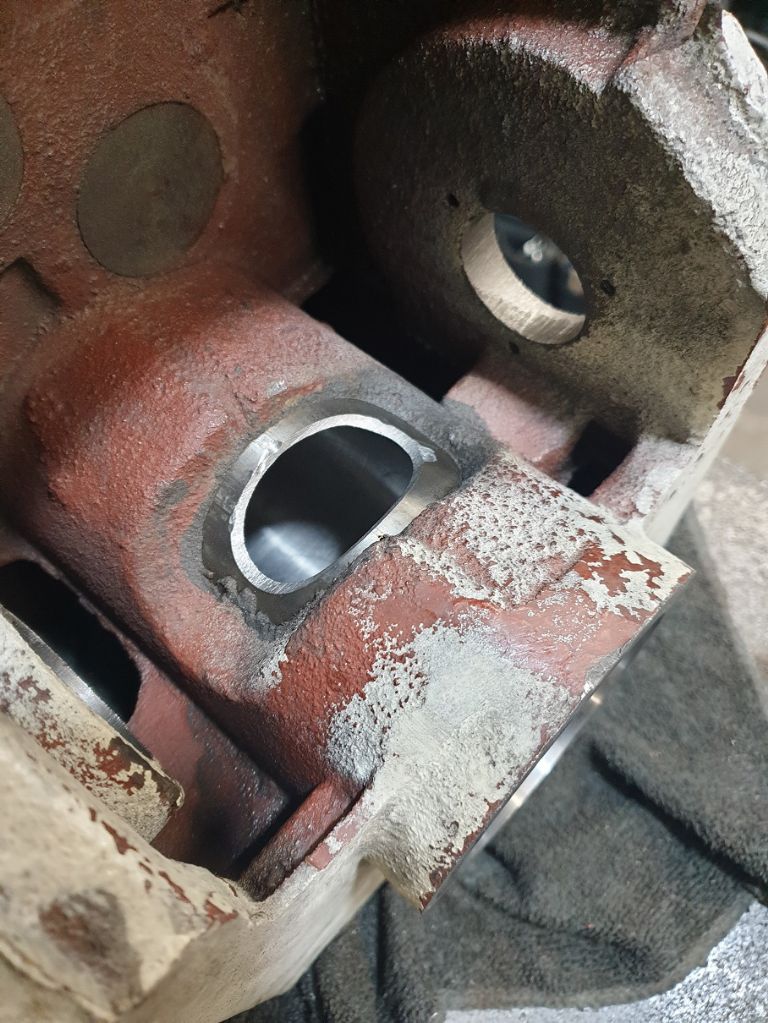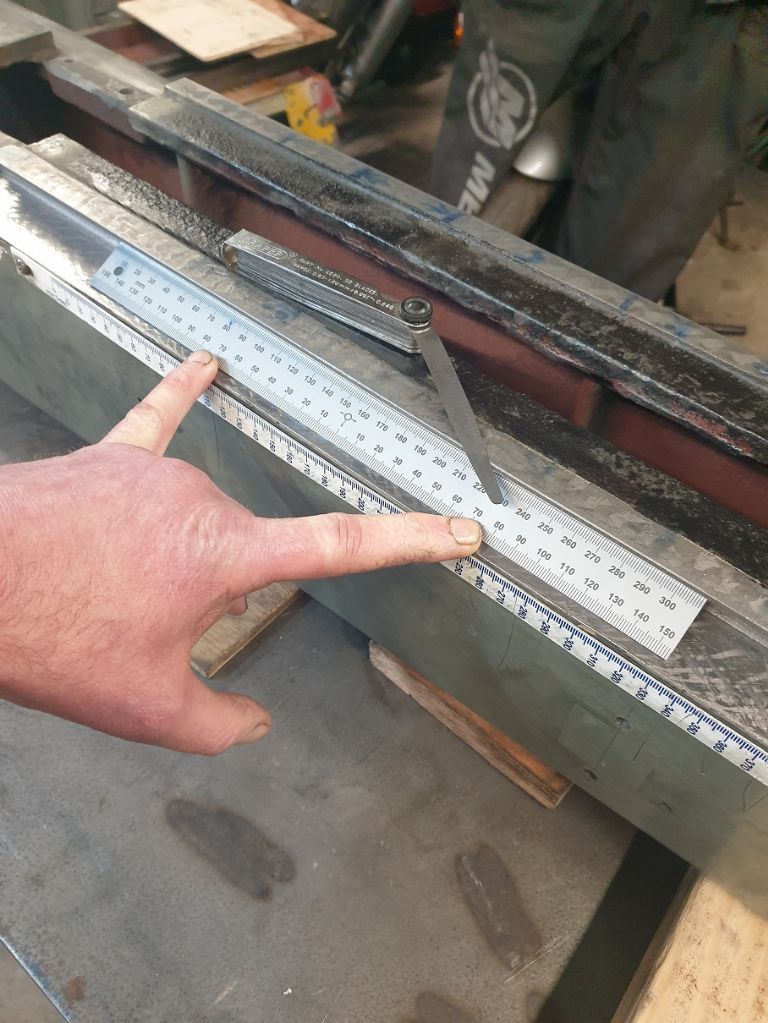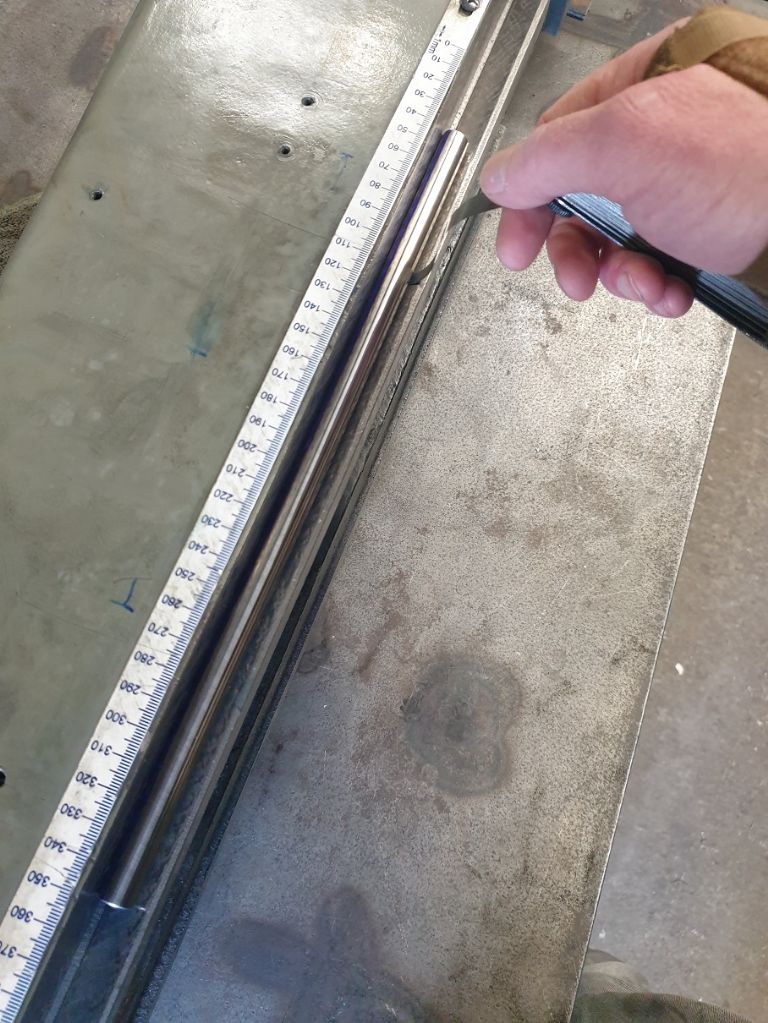Chester Super Lux advice
Chester Super Lux advice
Home › Forums › Manual machine tools › Chester Super Lux advice
- This topic has 174 replies, 22 voices, and was last updated 4 January 2025 at 16:47 by
 Taf_Pembs.
Taf_Pembs.
-
AuthorPosts
-
30 November 2022 at 23:32 #623237
 Taf_PembsParticipant@taf_pembs
Taf_PembsParticipant@taf_pembsEvenin'!
So.. set to the table. Got the Surface plate on the now reinforced baby welding table on 3 feet with some bracing support to prevent any rocking and then after more cleaning and stoning got the table down side up on it on a couple of shim strips.
After a bit of messing got it sitting pretty good with no fluctuation in indicator despite placing the saddle on it in various places so that will do me tidy.
Then, after mic'ing thickness for reference, mapped the main section of the ways and just used that to rough it in with the baby eclipse scraper. The mapping tied in nicely with the thickness check so everything seemed to be sitting nicely.
Just kept scraping, heavy stoning and mapping until it was all showing the same on the indicator.
Didn't have to take much off really, 0.05mm at the worst so cant complain!
once I was happy with what the indicator was saying I took a print with the saddle which I'm pretty happy with. Remarkably there was patchy blue over pretty much the whole area!
Ignore the measurements, hadn't cleaned them off.
I've only done 3 rounds since that photo and it's getting pretty close.
Only 2 real problems, first is the ware lip in by the dovetail on the non gib side, not much but had to go.. was a ball ache getting in to that without messing the dovetail.
Second is being able to see the blue in the light so a wee pot of Stuarts Red is en route, I couldn't find any other die for a contrast. Thought about food colouring but no. I've heard that some folks use cement pigment as that is fully soluble but found the red on the interweb so went with that.
Once the middle section is good, I'll do the outside 7 inches ish by just stepping the saddle out an inch or 2 at a time and bringing the untouched areas down until it prints good with the rest of the way.. best I can do with my set up I'm afraid but I think it'll work…. well.. it has to !
Unless anyone can offer a better solution, I've racked what's left of my brain but short of a 3 foot camelback I cant come up with anything??
Plugged up the quill drift slits too, still need dressing but roughed down to close.
That'll do for now..

Edited By Taf_Pembs on 30/11/2022 23:35:12
11 December 2022 at 17:05 #624558 Taf_PembsParticipant@taf_pembs
Taf_PembsParticipant@taf_pembsEvenin' All!
Despite a busy couple of weeks I have spent pretty much every spare hour 'scraping' (I use the term very loosely!!) the table ways. Probably made much longer by being too scared to take more than very light scrapes for fear of going too far and having to go over the whole thing again, but this afternoon I did my final 'dusting'.
Now, no matter where I place a lightly blued saddle in position on the table I get pretty much a full print… Extremely satisfying considering the set up, surface plate not big enough etc.
What is far more surprising is that moving the surface gauge all around the ways as far as the table will allow, shows less than 0.01mm variation everywhere !
Genuinely shocked at that, I wouldn't have though that would be achievable with what I have.. either that or my measuring is all to cock..

Suffice to say very very happy with that.
On to the base ways next..
11 December 2022 at 17:37 #624562 Taf_PembsParticipant@taf_pembs
Taf_PembsParticipant@taf_pembsSo after finishing the table and the surface plate being free again I placed the head on it sitting on the vertical saddle ways to see how that sits in relation to the quill.
Again, something of a shock.. with the quill extended a little under 5 inches and the indicator set to 0 nearest the head there was 0.04mm drop at the most extended part. Not bat at all.
However, I did notice when I was cleaning everything that when clean there was a bit more play in the quill to head bore than I though there should be. Lifting the quill gently takes the measurement from -0.04 to +0.12 at the nearly 5 inches extension. at 2 inches extension this drops significantly to 0.06 over all play.
Not bad really and if there is any extension of the quill required then the locks will be used.
Now there's another thing.. the quill locks, the 2 brass slugs that come together on the quill are just machined with a taper that clamp to the quill barrel. Why on earth would you have a flat clamping a cylinder??
Another job.. machine the flats of the locks to a radius that matches the quill.. surely that will hold far better.
As for the quill to head bore play, it occurred to me that there is a perfect solution readily available and is done in multiple automotive machine shops all over the country. Fit a piston liner and hone to suit.
Westwood Cylinder Liners in Worcestershire do a liner – WCL 16CFL that is 74mm bore, 5mm wall thickness so no problem there and 238mm long with a flange. No idea of price but might look into that as getting the head bored and fitting the liner is a very common and straight forward job.. just cos it's not an engine block shouldn't be a problem (I hope!), it is an easy enough set up. Liner can then be fitted and bored to suit the quill (just shy of 75mm).
I can then open out the areas for the quill guide pin, pinion, lock etc easy enough with a die grinder and burr.
Only issue is I have to decide on this before doing the column as that has to be the final adjustment to true everything else up I suppose.. Dear oh dear.. every day there is a decision to male ay!

 18 December 2022 at 15:01 #625340
18 December 2022 at 15:01 #625340 Taf_PembsParticipant@taf_pembs
Taf_PembsParticipant@taf_pembsSo in between shivering and trying to fit some celotex (other brands are available!
 ) to the roof of the garage as I'm finally getting round to adding some insulation I have now managed to 'map' the base ways in a rough way.
) to the roof of the garage as I'm finally getting round to adding some insulation I have now managed to 'map' the base ways in a rough way.Making the assumption that the 'ground' (I use the term loosely!) surface between the base ways was intended as the reference surface to build the thing I used that to depth mic the ways. the base of the depth mic is wide enough to take a measurement close in by the dovetail and also out towards the edge of the ways.
The results ether mean I have a huge amount of scraping to do
 or there is a significant difference between the plane of the ways and the 'ground' surface.
or there is a significant difference between the plane of the ways and the 'ground' surface. Here are the depth's from the ground surface, just the decimal of the mm is there.
So, taking the .31 as the lowest point I re numbered using that as the 0 mark.
I also then took a heavy print and that seems to match up with the numbers pretty well so I have reasonable confidence in my measurements.
PS… If anyone sees cockups in my maths please let me know!
Back to insulating when the rest of the boards arrive then some scraping I suppose!

 18 December 2022 at 16:08 #625345
18 December 2022 at 16:08 #625345 Martin ConnellyParticipant@martinconnelly55370
Martin ConnellyParticipant@martinconnelly55370I think there is supposed to be clearance between that ground surface and the table above it. So, don't spend any time working to get it flat.
Martin C
18 December 2022 at 16:35 #625347 Taf_PembsParticipant@taf_pembs
Taf_PembsParticipant@taf_pembsHi Martin, sorry, I should have been clearer, I have just written the measurements on the top surface to allow for taking a print and working our after scraping etc, they don't refer to the ground surface but points on the ways 22.** mm down from the 'ground' surface so my intention is to bring those 2 ways flat and co planer as best I can.
 18 December 2022 at 19:57 #625359
18 December 2022 at 19:57 #625359 Martin ConnellyParticipant@martinconnelly55370
Martin ConnellyParticipant@martinconnelly55370I've re-read your post and see what you are planning now. In that case I think you need to be careful using that surface as a reference plane. The level you used on the ground surface can bridge over low spots that a depth mic will not. Not knowing the order the surfaces of the base were originally machined in or how well the casting was aged before machining it puts its quality as a reference surface in doubt. I think you need to check the height of the scraped surface relative to the surface plate it is resting on. Shim it (or use machine jacks) so that three corners are the same height then take your measurements to find how the scrapped surfaces relate to those 3 corners. Put support under the fourth corner as well to avoid droop of any sort in the base casting.
Martin C
19 December 2022 at 10:33 #625381larry phelan 1
Participant@larryphelan1Full marks for hanging in here for so long .
9 January 2023 at 20:50 #628369 Taf_PembsParticipant@taf_pembs
Taf_PembsParticipant@taf_pembsEvenin'!
And a happy new year to all

Well, in between this work thing, insulating workshop (what a difference!!) oh and that Christmas thing etc I have now managed to get round to the base ways.
Unfortunately the initial measurements I took as depths form the 'reference' surface must have been pretty good as the amount of material that needed removing from the r/h side in order to start getting a sensible print was daft..
I started very light as I have done through out, mainly due to a lack of confidence but I ended up getting all neanderthal on the thing… eventually blue started appearing on both sides of both ways.. I thought I was going daft!
Just using the freshly checked saddle to print, I just did the centre section, placing it in situ and gently sliding it between the blue 'horizontal' lines marked on the face then once that was done, stepped it out to bring down the rear and front sections of the face until the blue on the already scraped section began to expand towards the higher bits then just went really careful until no matter where I placed the saddle with a light bluing I got a decent print. Same process as the table really.. seemed to work OK!
Here was the centre section almost done..
And here is the whole thing almost done.
I've given up trying to take pics of the finished article, with a very light print and shiny metal there is nothing to see so basically it looks similar to this but with a more consistent and shorter scrape pattern rather than the rough that is here.
The column next.. however, the only way I could print to that would be to use the column saddle which I really don't think is long enough to show anything meaning full. I will have a go to see if it gives an impression of how good / bad or ugly it is but not sure I've much chance of doing much with it without potentially making it worse.
A mate has kindly offered to assist with machining the oil ways (he has a mill.. bonus!) rather than trying to mess it up by hand so when ever the cheep one shot oiler kit gets here and I decide where and how to drill I can then get those done.
Still haven't decided whether to do the quill, fit and hone a liner or leave as is. I keep thinking that if I'm doing all this then I may as well but it's 60 odd quid for the liner + what ever machining costs. Have to wait and see what the next month or so brings (i.e. lottery ticket!)..
The other little gremlin that keeps nagging in my ear keeps on whispering 'ball screws, ball screws, ball screws and motors' the little **** but I'm afraid I'm not listening, the credit card has already had a bashing by needing a new telly and paying for insulation let alone how much that would cost, I bet that would be well into 4 figures to complete..

All the best..


 21 January 2023 at 15:04 #630479
21 January 2023 at 15:04 #630479 Taf_PembsParticipant@taf_pembs
Taf_PembsParticipant@taf_pembsArfnoon all..!
I hade a go at using the Column saddle to print to the column ways just to get an idea of how they are.
Re checked the saddle on the surface plate and gave it a light stoning .. all was good.
Inked her up and went for it.
Oh dear… I've seen straighter roundabouts!
I placed the saddle at various points on the column and just just a short rub back and for (about an inch only) so as to just look at the localised area.
At a guess I would say between 0 and 5% contact.. I say 0 as there were large areas that I simply wouldn't print.
No choice really but to go for it. Print, scrape move a couple of inches, print, scrape move etc etc.
I didn't concentrate on any one area at a time so as not to go too far and ruin the whole thing as an area further down may have brought the low area into the ball park so just kept working up and down until I had a reasonable print.
Here is a pic that I have set up with heavy ink (so it would photo!) just to show my method with the saddle and all the 'hieroglyphics' I was using to keep a reference on where I was moving up and down the column – it might make more sense to someone thinking about it…
At this stage I was just chasing the blue high spots to try to bring it even both sides.
This is getting close now, there were only a couple more goes to get decent prints regardless where on the column I placed the saddle so now I only have to try to scrape a few oil pockets into it and it's done (again, heavy ink set up and multiple prints just to be able to take the pic!).
Unfortunately I am off in for surgery (wrist) on Wednesday (the bloody 3rd one!) so will be out of action for a bit but at least the bulk of the scraping is done.
What I'm going to do about the dovetails I have no idea as I have no way to print them or have a reference surface. I will put some ink on them to see how they are but that may be a bad thing as I will then know how bad that are!
A fella I know at a local firm is going to give me a price to machine the gear head and fit the liner so that can be sorted and if the price is right I think I may as well do it .. going this far and not doing it seems a little daft now.
I know in Pembrokeshire we don't have a word in the dictionary for anything as remotely as urgent as Manyana but she'll get there..


 21 February 2023 at 13:54 #634476
21 February 2023 at 13:54 #634476 Taf_PembsParticipant@taf_pembs
Taf_PembsParticipant@taf_pembsAllo all..!
Well, after trying to get some prices for boring out the mill head and fit a liner to address the quill not being a great fit in the sleeve it seems that most places don't really want to do it (the're all busy to be fair) and the quotes I did were unfortunately a little unaffordable for me.
So.. if you don't try you don't learn I suppose..!
Had an old landrover half shaft that I thought would make a good line boring bar so made use of that.
Cut down a 10mm boring bar so it would do the job.
I've set the mill head on the lathe saddle with the cross slide removed and spent more hours than I care to mention packing, shimming and tapping it into position.
There is just enough room on the bed for the whole operation to be completed on the unworn area of the lathe bed, not that there is much but it is measurable in the normal area close to chuck.
Got a plate set up against the back of the mill head so I have a reference to set the cutter depth increments.
Got the head set so the bore will be true to the head mounting face ( I hope!)
The cutter will run in the normal lathe rotation so it is on the down stroke on the apron side as that is the 'loosest', the rear of the saddle has full length under support so the cut will end roughly in the position in the last photo – by taking the knobs off the tail stock handles it passes them perfectly!
Bar is set up between centres to I can remove it for measuring.
If there is anything I have missed or got wrong I would very much appreciate any advice..!
Here are a couple of pics of the set up.
Cheers..!
 9 March 2023 at 11:44 #636839
9 March 2023 at 11:44 #636839 Taf_PembsParticipant@taf_pembs
Taf_PembsParticipant@taf_pembsAftnoon..!
A little progress, things are very slow now I'm 1 handed for a bit post surgery but we're getting there.. (but then they said that about British Rail!).
Boring went remarkably well, hit all the numbers I wanted to. While the head stock was still mounted in the lathe I got the liner out of the freezer and with the liner against the face plate used the carriage (and tail stock for the last bit) to press it into the head. Went in perfectly although I stopped short as the top end of the bore has a really thin section for clearance to 1 of the gear shafts, I didn't want to be cracking it for the sake of losing about 1 inch of the liner.
And the thin bit, after boring it's only about 2 mm thick..
Some odd what I can only assume are chatter patterns in the very top end of the original bore but not an issue, it was fine once the cutting had more meat around it.
Liner now fitted, bored and honed..
The sleeve may need another very light honing as the Quill needs a little touch to fall out on it's own but going to leave as is until I try it. I did warm the quill up by about 20' C to make sure it would still move to allow for any expansion due to bearing temp increase and it did .. just! Well happy with that.
I've now opened up the ports for the Quill lock and the pinion gear, that also seemed to go pretty well,
Finished (possibly!) bore and ports.. just a drill hole or 2 for guide pin and lube etc to do but essentially that is done.. not only surprised my self but learnt a lot in the process so a good exercise !
Fly cutter in the lathe to face the end.. had a bit of chatter on the last cut so will need a wee bit more stoning to dress that out.. (below)
What to do next… soo much to choose from.. oil grooves, drillings to suit 1 shot oiler, column .. then reassemble and check .. gib shims etc.. may be some time.. It will live again – honest!

 10 March 2023 at 07:30 #636996
10 March 2023 at 07:30 #636996John MC
Participant@johnmc39344I'm pleased to see this thread get going again, I recently bought a very similar machine, Cormak ZX7045. I'm hoping Taf's solutions might help me sort it out.
Regarding the "sloppy" quill fit, my machine seems okay, a tiny bit of play with the quill almost out of its hole otherwise good. It occurred to me that a simpler solution too removing the play in the quill might be to machine a slit in to the housing and fit a bolt (or two) to close up the unwanted clearance?
I've seen this technique used on older industrial machines, probably as a means of compensating for wear rather than achieving the initial fit?
I have found a number of problems with the Cormak mill so will start a new thread rather than highjack Taf's thread.
John
10 March 2023 at 11:31 #637030 Taf_PembsParticipant@taf_pembs
Taf_PembsParticipant@taf_pembsHi John,
It's taking a while to get through this, unfortunately a wrist injury seems to be going backwards not forwards so trying to do everything pretty much 1 handed is just slowing everything down a bit. I was a righty but now pretty well a lefty.. wonderful how the body adapts!
There obviously needs to be some play in the quill to allow free movement, but mine was pretty excessive, no issue for milling as the quill would be locked but when drilling, the distance down to the end of the bit amplified the problem.
As there was no obvious or measurable ware on the 2 small contact rings (machining marks barley touched) in the quill sleeve and nothing on the quill I decided to do something about it. It was just made really poorly.
It has worked fantastic as well as given me much more confidence and now instead of 2 short contact rings fairly close together low down the bore I have pretty well full length support to the quill.. a huge difference, looking forward to trying it but at this rate that will be some time!
I don't regret buying it, far from it I love a challenge and really enjoying doing it and when its done I reckon I'll have a fairly decent machine although the list of jobs I had lined up for it is growing somewhat!
 10 March 2023 at 16:53 #637067
10 March 2023 at 16:53 #637067Lathejack
Participant@lathejackGreat work, and a fairly major task. It must have been a little daunting to finally switch on and start taking the first cut in the bore, no turning back once you get going.
I've often wondered how much bearing surface there is inside the bore for the quill on many of these mills. From your earlier photos, and other images of them, I had assumed they had bored the full length of the internal casting, or most of it, to fit the quill. So was a bit disappointed that there was only a couple of short areas of bearing surface for the quill, but I suppose that is a lot quicker and easier for the manufacturer.
The Condore and Bridgport mills we have at work, and the new Bridgeport clones I have looked at, have a quill that is a very close fit in the head casting, so there is a small amount of drag on the sliding quill. A Hobbymat BFE mill I once owned was manufactured with a cast iron liner in the Alluminium alloy head casting that was bored and honed with a cross hatch pattern to a very close fit to the quill, with no detectable play and a small amount of drag on the quill.
Where did you get the iron liner from? What was it originally intended for, or was it made to suit your purpose?
I have a lightly used 1997 Taiwanese made Warco VMC mill that I bought when it was only a few months old. The head casting is bored for its full length to suit the quill diameter, and there is a small amount of clearance around the quill which is a free sliding fit in the bore with no drag. This clearance really shows up when using a boring head with its single point cutter, as the quill slides further out lubricating oil can just be seen being squeezed in and out of the small clearance as the quill rolls around in the bore as the single cutter rotates.
Anyway, really great work and always interested to see more.
10 March 2023 at 19:14 #637090 Taf_PembsParticipant@taf_pembs
Taf_PembsParticipant@taf_pembsThanks for the encouragement, appreciate it! As long as some folk find it useful or worth reading I'll keep posting how how it goes.
Yes, there was a fair amount of nerves taking the first cut, I went though it dry so to speak many times before actually cutting to try to make sure what I was doing was going to work.. measure twice cut once?.. no.. measure 20 times and cut once!
As a get out I had spoken to a couple of local machine shops to get an idea of what it would cost me to put right if I cocked it up .. a couple of hundred quid although I expect a good engine boring firm would be somewhat less as they have dedicated boring and honing set up's ready to go.
The Liner came from Westwood Cylinder Liners *Here* .Browsed by size and came up with the WCL 16B. I had thought originally to use the WCL 16CFL that was much thicker and with a lip but no need to take anything like that amount of material. The WCL 16B was about £52 with vat and carriage Carriage was expensive, 12 quid + vat I think but was the right one for the job.
 13 March 2023 at 07:59 #637452
13 March 2023 at 07:59 #637452John MC
Participant@johnmc39344Another thought on removing the excess clearance from the quill. Chrome plate the quill. A generous layer of decorative chrome might do it, If not then industrial chrome. Reduce the diameter of the quill, plate to oversize then grind to suit the hole. The rack and internal features can be masked so as not to alter its sizes.
This works very well on Bridgeport mills, among others.
As for costs, don't know. Probably not that expensive as its a common enough process these days.
Taf, hope the work on the mill is progressing well, keep the thread going, its interesting.
John
13 March 2023 at 11:11 #637485Ex contributor
Participant@mgnbukAs for costs, don't know. Probably not that expensive as its a common enough process these days.
The machine tool rebuild / retrofit company I used to work for used the grind / hard chrome / grind to size method to sort out worn ailstock barrels & worn bearing seats on spindles. The parts were larger than model engineering friendly machinery, but 20 years ago the costs were significant & the process slow – an initial grind to remove wear and impart a very good finish to the part before sending out to the platers for the actual plating, then return to the grinder to finish grind. One issue that frequently occurred was the plating not adhering to the component, something that did not reveal itself until the finish grinding operation when the plating would flake off. This required the entire surface to be ground back to the parent metal & then replating. On one component (a Crawford Swift spindle with worn bearing seats) this happened four times before the part was completed – a process that took several weeks.
The last part I had repaired this way was the tailstock barrel on a CNC lathe that the operator crashed the tool turret into at rapid traverse This bent the 100 mm diameter barrel by 0.05mm – not a lot, but enough to sieze it in the housing. This was ground on the OD to remove the bend, plated oversize, ground back to original size and the 5MT taper reground true to the OD – IIRC this cost £400 + Vat around 10 years ago.
We used to use a company in LIversedge, West Yorks – Brian Kemp Grinders – for this type of work & usually sent both the component to be plated + the component it ran in to them. They honed the bore & ground the plated part to give the required fit. Brian passed away many years ago, but his wife continued to run the company. They still have a current website.
I suspect that Taf's solution will be a lot cheaper + produces a full length bore..
Nigel B.
13 March 2023 at 17:33 #637521 Taf_PembsParticipant@taf_pembs
Taf_PembsParticipant@taf_pembsAllo..!
Plating wasn't really a consideration for me as the bore only had 2 short poorly machined contact areas, 1 right at the bottom and 1 a couple of inches up, just above the quill pinion and quill lock ports. These contact areas were barely 1 &1/2 inches wide each. The rest of the bore was relieved by about 30 thou ish.
My thinking was that a 'full contact' bore, even if not the most perfect finish would give far more support and less play than these 2 short rings low down on the quill.
Grinding and plating would be the best way to do it I would think if the head / bore were sturdy and accurate enough, silky smooth and no play but way beyond my budget I'm afraid..
Unfortunately I have a far more pressing problem….
 13 March 2023 at 18:01 #637525
13 March 2023 at 18:01 #637525 Taf_PembsParticipant@taf_pembs
Taf_PembsParticipant@taf_pembsSo… Houston we have a problem.
How to measure the flatness and parallelism of dovetails without a dovetail straight edge and a mic big enough.
When I first got the mill I had real problems adjusting the vertical slide gib. Tight (ish) then proper loose, and nowhere in between. no matter what I did I could get nothing consistent. Even in the tightest area the gib was inserted way to far and would need a serious shim.
As the column is still on the work table I thought I would put a light blue on the saddle sliding dovetail and see what it looked like. No point in taking a pic as it was as flat as the Pennines.
I did try to scrape some of the lumps down a bit just to get a little more even contact before trying to get some sort of measurements and also an idea of how thick a shim would be needed.
The best I could do to to measure was using a pair of 10mm carbide end mills (need 12 or 13 really) and my Mitutoyo vernier (I have learnt to trust it fairly well, its good but no Mic).
I thought I was being kift as there was a narrowing of well over 10 thou in the mid area.
I placed the saddle on the column at the top area and inserted the gib so just nipped and no play. Measured the stick out of the gib. Then same further down, etc etc. in the mid section the gib sticks out over an inch more than at the top or bottom.
I'm reasonably confident that the slide ways are pretty flat as placing the (blued) saddle anywhere on the column produces a full print, I appreciate it's not perfect but all I could do so I believe the issue is with the dovetails.
Going to have to get the thinking cap on and work out a way to get at least 1 dovetail flat then at least I have a starting point.
The other thing, the dovetail angle, as best as I can measure, scribing on to paper, angle gauge etc etc is 53 Deg.. I've never seen a 53 Deg cutter and can not find one on the interweb ?? If I could, I'm sure the column could be mounted some how on a mill and skim cut the dovetails.
Oh for a camel back .. no chance of affording one !
Not much point in continuing until I can sort this.. I suppose I did say I liked a chalenge!
Any suggestions greatly appreciated!
 13 March 2023 at 19:50 #637537
13 March 2023 at 19:50 #637537 Taf_PembsParticipant@taf_pembs
Taf_PembsParticipant@taf_pembsOk..
Tutting, laughing, eye rolling, frowning head shaking etc etc..
All the above are fully permitted and no offence will be taken!!

Had a thought on a way to find out if it was 1 side or both or at least to maybe prove that I'm not measuring kift..
I took my cleanest thin straight edge I could quickly lay my hands on, balanced it on the surface plate with a light behind and then gently stoned it until it would sit on its edge with no light showing under the edge.
Laid it against the dovetail with a pair of end mills behind for repeatability and a consistent angle as close to 90 deg to the dovetail as possible.
Repeated each side in several positions to confirm repeatability… it seemed to show something I can work with!
On the non gib side, no mater where I set it I could not get a 1 thou feeler gauge between edge and dovetail, this is the side I did a wee bit of scraping on.
On the Gib Side, in the mid section in the same area I was showing the biggest reduction in when measuring with end mills and calliper, also where the biggest protrusion of the gib was when trying it in the saddle I could easily get a 0.07 / 2.8 thou feeler gauge in the gap and this reduced towards either end of the column.
At least I have something to work with… I think!
The above laughing, tutting, head shaking etc may now commence…

 22 March 2023 at 15:35 #638669
22 March 2023 at 15:35 #638669 Taf_PembsParticipant@taf_pembs
Taf_PembsParticipant@taf_pembsGetting creative with the dovetails..
Really didn't like the ruler, it gave an idea but no good really.
Not having a camel back or any kind of master to be able to print the dovetails has caused much head scratching..
I did email Clive Lamb for a price on an 18" (or his nearest size) camel back to do flats and dovetails and despite being a good price compared to everything I see second hand it was out of reach for me I'm afraid (am saving up though!) – he said the foundry had put prices up around 50% !
So all I needed to do was get 1 side flat then use that to measure to the other to get them parallel.
I had a fresh length of ground silver steel 1/2" rod, Ideal side for contact with the mid point of the dovetail, rolled it on the surface plate with a light behind and at 1 point it was in perfect contact along its whole length so I put a sharpie mark on the opposite side so I could lay it in the dovetail in the correct position and used a feeler gauge to find the variation.
Seemed to work pretty well so I used it to check the corresponding dovetail on the saddle and fortunately the non gib side needed almost do scraping to get it bob on. Then used that in the same way as I did doing the flat ways, i.e. start at the lowest area, print it to find the high spots, move a couple of inches to one side or t'other and repeat until regardless of where the on the column I printed I had a full length print.. I may be wrong but I don't see how there can be any variation then (certainly not enough to make any difference to me!). Kept checking with the ground rod just as a check that was I was doing was working.
Far from ideal but it seems to have worked!
I can now measure to the other side to get parallel.
I'm still baffled as to how the whole thing could have been so far out but it certainly explained why when I got the thing and tried to do some cuts, particularly fly cutting, it gave such poor and random results.
I suppose if I manage to finish this thing I'm going to have to find something else to blame for my crap parts!

 24 April 2023 at 14:29 #642447
24 April 2023 at 14:29 #642447 Taf_PembsParticipant@taf_pembs
Taf_PembsParticipant@taf_pembsAfternoon all..
Well.. unfortunately nothing to update, complications from the 3rd round of surgery on my wrist is basically preventing me form moving anything other than the lightest parts round the workshop.. even got to call a mate up to change chucks on the lathe.. can just about manage the 3 jaw and the collet but that's a struggle.
I have managed to spend a week or so addressing the damp issue in the workshop.. the render on the main south facing weather wall was cluck as hell .. no issue with the bond to the wall but seriously cracked which I found by scraping some of the paint off. So, after a strip off with a jet wash and painting a waterproofing slurry mix over the whole wall and all the cracks in the other walls I'm now waiting for a decent dry spell to give it a coat of that Bedec extraflex paint to finish the seal of the walls. It should have been a day or 2's work but took well over a week being basically 1 handed.. hay ho.. at least it's keeping me busy and providing a bit of physio..
I am hopefully waiting on a bit of kit that is going to help with the mill but will have to wait and see..
Next job is I have to save up for a new garage door, my sectional insulated electric door takes up around half of the head space so need one that is a roller affair so I can fit a unistrut over head gantry set up to be able to move stuff round the workshop .. if I can do it so it will lift around 80kg that will be fine for what I need then I can get back to doing some useful stuff !
Cheers for now..
 25 April 2023 at 17:13 #642573
25 April 2023 at 17:13 #642573larry phelan 1
Participant@larryphelan1You deserve a medal for hanging in there for so long !
30 ,10 2022 ?
26 April 2023 at 10:29 #642646John MC
Participant@johnmc39344Keep going when you are able Taff, you will hve a fine machine in the end!
-
AuthorPosts
- Please log in to reply to this topic. Registering is free and easy using the links on the menu at the top of this page.
Latest Replies
Home › Forums › Manual machine tools › Topics
-
- Topic
- Voices
- Posts
- Last Post
-
-
I’m Under Pressure
1
2
Started by:
howardb in: Related Hobbies including Vehicle Restoration
- 16
- 28
-
11 July 2025 at 01:12
howardb
-
Sat nag
Started by:
duncan webster 1 in: The Tea Room
- 13
- 25
-
10 July 2025 at 23:09
duncan webster 1
-
Transwave converter – plugged in motor, tripped RCD
Started by:
ell81 in: Beginners questions
- 8
- 12
-
10 July 2025 at 22:56
Master of none
-
Maisie lubricator
Started by:
ferroequinologist in: Locomotives
- 8
- 13
-
10 July 2025 at 20:40
ferroequinologist
-
Old plastic handled screwdrivers
Started by:
 Dave Halford
in: Workshop Tools and Tooling
Dave Halford
in: Workshop Tools and Tooling
- 10
- 12
-
10 July 2025 at 17:21
 Russell Eberhardt
Russell Eberhardt
-
Eight Trains
Started by:
 Vic
in: The Tea Room
Vic
in: The Tea Room
- 1
- 1
-
10 July 2025 at 14:14
 Vic
Vic
-
motor and switch wiring Myford ML7
Started by:
1957jmh in: Workshop Tools and Tooling
- 3
- 5
-
10 July 2025 at 12:02
noel shelley
-
Help Wire 3 Phase 2 Speed Motor
Started by:
Allan Day in: Electronics in the Workshop
- 13
- 23
-
10 July 2025 at 11:57
Andrew Skinner
-
Square end on round stock – Milling?
1
2
Started by:
Roger TheShrubber in: Workshop Tools and Tooling
- 16
- 29
-
10 July 2025 at 10:49
 Julie Ann
Julie Ann
-
Easiest/cheapest source of R8 socket
Started by:
Beardy Mike in: Workshop Tools and Tooling
- 8
- 10
-
10 July 2025 at 10:16
Pete
-
New (but well aged) member
Started by:
mikemunson in: Introduce Yourself – New members start here!
- 6
- 6
-
10 July 2025 at 09:23
 Dell
Dell
-
Bosch PBD 40 bearing upgrade
Started by:
th1980 in: Manual machine tools
- 5
- 11
-
9 July 2025 at 22:00
th1980
-
Farm Boy
1
2
3
4
Started by:
Dalboy in: I/C Engines
- 15
- 100
-
9 July 2025 at 20:58
Dalboy
-
Bearing boxes for ball race
Started by:
Paul McDonough in: Beginners questions
- 11
- 20
-
9 July 2025 at 20:38
old mart
-
Twin Engineering’s heavy mill/drill quill removal
1
2
Started by:
Martin of Wick in: Manual machine tools
- 11
- 34
-
9 July 2025 at 19:42
old mart
-
File backup to external hard drive, incremental etc?
Started by:
Peter Bell in: The Tea Room
- 11
- 17
-
9 July 2025 at 13:50
 Graham Stoppani
Graham Stoppani
-
Boiler Design – issue 4765
1
2
…
7
8
Started by:
Charles Lamont in: Model Engineer & Workshop
- 26
- 186
-
9 July 2025 at 12:28
Paul Kemp
-
Taylor Hobson cutter grinder modificaton
1
2
Started by:
 David George 1
in: Workshop Tools and Tooling
David George 1
in: Workshop Tools and Tooling
- 9
- 34
-
8 July 2025 at 23:53
 Bazyle
Bazyle
-
Angle grinder woes
Started by:
Speedy Builder5 in: Workshop Tools and Tooling
- 5
- 8
-
8 July 2025 at 18:26
DC31k
-
in line oil check valve
Started by:
 Garry Coles
in: General Questions
Garry Coles
in: General Questions
- 5
- 5
-
8 July 2025 at 18:05
salatipa
-
Chester Champion, warco ZX15 drawbar
Started by:
martian in: Manual machine tools
- 4
- 6
-
8 July 2025 at 16:49
martian
-
Bridgeport ways and wear
Started by:
inline in: Manual machine tools
- 6
- 17
-
8 July 2025 at 15:44
duncan webster 1
-
Drilling holes in blades?
Started by:
Bo’sun in: The Tea Room
- 8
- 20
-
8 July 2025 at 15:28
 Bazyle
Bazyle
-
Need help choosing a lathe chuck
1
2
Started by:
th1980 in: Workshop Tools and Tooling
- 21
- 38
-
8 July 2025 at 13:30
 JasonB
JasonB
-
After all these years … I fell for a scam :(
Started by:
 Michael Gilligan
in: The Tea Room
Michael Gilligan
in: The Tea Room
- 4
- 6
-
8 July 2025 at 12:58
 Robert Atkinson 2
Robert Atkinson 2
-
I’m Under Pressure
1
2
-


